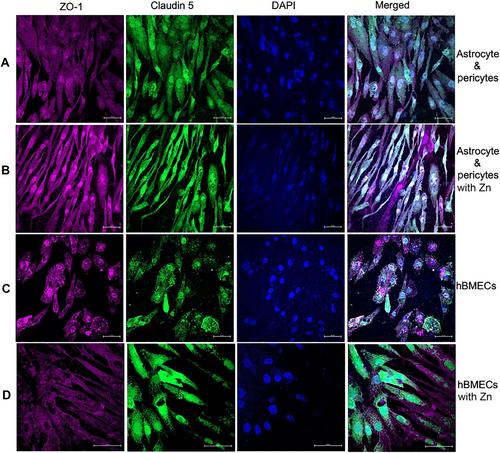Establishment of a Four-Cell In Vitro Blood-Brain Barrier Model With Human Primary Brain Cells
Johid R. Malik, Ukamaka O. Modebelu, Courtney V. Fletcher, Anthony T. Podany, Kimberly K. Scarsi, Siddappa N. Byrareddy, Robbyn K. Anand, Shilpa Buch, Susmia Sil, Jennifer Le, John S. Bradley, Ashley N. Brown, Debapriya Sutar, Sean N. Avedissian
下载PDF
{"title":"Establishment of a Four-Cell In Vitro Blood-Brain Barrier Model With Human Primary Brain Cells","authors":"Johid R. Malik, Ukamaka O. Modebelu, Courtney V. Fletcher, Anthony T. Podany, Kimberly K. Scarsi, Siddappa N. Byrareddy, Robbyn K. Anand, Shilpa Buch, Susmia Sil, Jennifer Le, John S. Bradley, Ashley N. Brown, Debapriya Sutar, Sean N. Avedissian","doi":"10.1002/cpz1.1067","DOIUrl":null,"url":null,"abstract":"<p>The blood-brain barrier (BBB) constitutes a crucial protective anatomical layer with a microenvironment that tightly controls material transit. Constructing an <i>in vitro</i> BBB model to replicate <i>in vivo</i> features requires the sequential layering of constituent cell types. Maintaining heightened integrity in the observed tight junctions during both the establishment and post-experiment phases is crucial to the success of these models. We have developed an <i>in vitro</i> BBB model that replicates the cellular composition and spatial orientation of <i>in vivo</i> BBB observed in humans. The experiment includes comprehensive procedures and steps aimed at enhancing the integration of the four-cell model. Departing from conventional <i>in vitro</i> BBB models, our methodology eliminates the necessity for pre-coated plates to facilitate cell adhesion, thereby improving cell visualization throughout the procedure. An in-house coating strategy and a simple yet effective approach significantly reduce costs and provides superior imaging of cells and corresponding tight junction protein expression. Also, our BBB model includes all four primary cell types that are structural parts of the human BBB. With its innovative and user-friendly features, our in-house optimized <i>in vitro</i> four-cell-based BBB model showcases novel methodology and provides a promising experimental platform for drug screening processes. © 2024 The Authors. Current Protocols published by Wiley Periodicals LLC.</p><p><b>Basic Protocol 1</b>: Coating and culture system</p><p><b>Basic Protocol 2</b>: Cell seeding and Transwell insert handling</p><p><b>Basic Protocol 3</b>: Assessment of model functionality</p>","PeriodicalId":93970,"journal":{"name":"Current protocols","volume":"4 6","pages":""},"PeriodicalIF":0.0000,"publicationDate":"2024-06-10","publicationTypes":"Journal Article","fieldsOfStudy":null,"isOpenAccess":false,"openAccessPdf":"https://onlinelibrary.wiley.com/doi/epdf/10.1002/cpz1.1067","citationCount":"0","resultStr":null,"platform":"Semanticscholar","paperid":null,"PeriodicalName":"Current protocols","FirstCategoryId":"1085","ListUrlMain":"https://onlinelibrary.wiley.com/doi/10.1002/cpz1.1067","RegionNum":0,"RegionCategory":null,"ArticlePicture":[],"TitleCN":null,"AbstractTextCN":null,"PMCID":null,"EPubDate":"","PubModel":"","JCR":"","JCRName":"","Score":null,"Total":0}
引用次数: 0
引用
批量引用
Abstract
The blood-brain barrier (BBB) constitutes a crucial protective anatomical layer with a microenvironment that tightly controls material transit. Constructing an in vitro BBB model to replicate in vivo features requires the sequential layering of constituent cell types. Maintaining heightened integrity in the observed tight junctions during both the establishment and post-experiment phases is crucial to the success of these models. We have developed an in vitro BBB model that replicates the cellular composition and spatial orientation of in vivo BBB observed in humans. The experiment includes comprehensive procedures and steps aimed at enhancing the integration of the four-cell model. Departing from conventional in vitro BBB models, our methodology eliminates the necessity for pre-coated plates to facilitate cell adhesion, thereby improving cell visualization throughout the procedure. An in-house coating strategy and a simple yet effective approach significantly reduce costs and provides superior imaging of cells and corresponding tight junction protein expression. Also, our BBB model includes all four primary cell types that are structural parts of the human BBB. With its innovative and user-friendly features, our in-house optimized in vitro four-cell-based BBB model showcases novel methodology and provides a promising experimental platform for drug screening processes. © 2024 The Authors. Current Protocols published by Wiley Periodicals LLC.
Basic Protocol 1 : Coating and culture system
Basic Protocol 2 : Cell seeding and Transwell insert handling
Basic Protocol 3 : Assessment of model functionality
利用人类原代脑细胞建立四细胞体外血脑屏障模型
血脑屏障(BBB)是一个重要的解剖保护层,其微环境严格控制着物质的转运。要构建能复制体内特征的体外血脑屏障模型,需要按顺序将组成细胞类型分层。在建立和实验后阶段保持观察到的紧密连接的高度完整性对这些模型的成功至关重要。我们开发了一种体外 BBB 模型,它复制了在人体中观察到的体内 BBB 的细胞组成和空间方向。实验包括全面的程序和步骤,旨在加强四细胞模型的整合。与传统的体外 BBB 模型不同,我们的方法无需使用预涂布板来促进细胞粘附,从而改善了整个过程中的细胞可视化。内部涂布策略和简单有效的方法大大降低了成本,并提供了卓越的细胞成像和相应的紧密连接蛋白表达。此外,我们的 BBB 模型还包括作为人体 BBB 结构部分的所有四种主要细胞类型。我们内部优化的基于四种细胞的体外 BBB 模型具有创新和用户友好的特点,展示了新颖的方法论,为药物筛选过程提供了一个前景广阔的实验平台。© 2024 作者。当前协议》由 Wiley Periodicals LLC 出版。基本方案 1:涂层和培养系统 基本方案 2:细胞播种和 Transwell 插片处理 基本方案 3:模型功能评估。
本文章由计算机程序翻译,如有差异,请以英文原文为准。


 求助内容:
求助内容: 应助结果提醒方式:
应助结果提醒方式:


